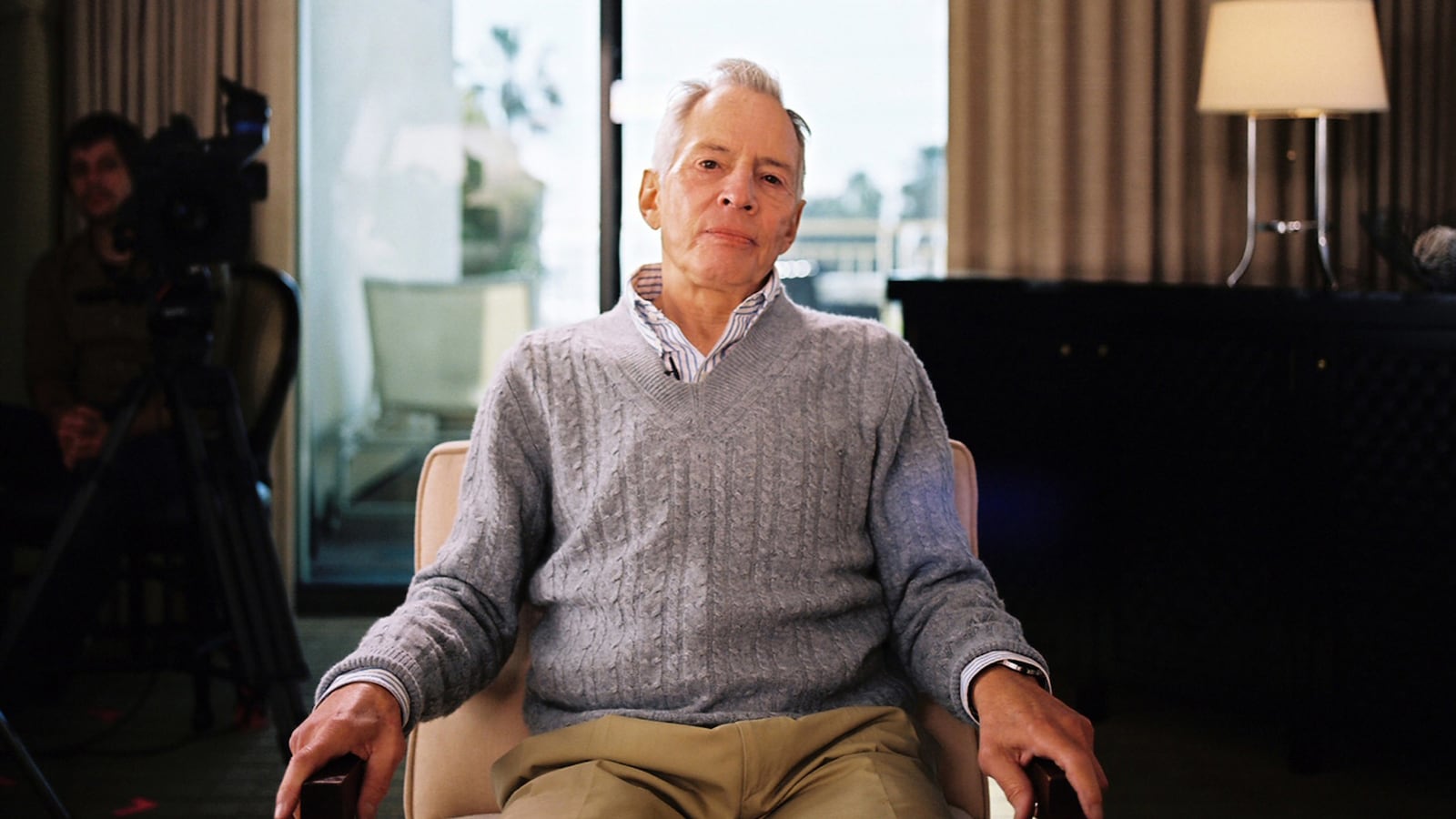Near the end of Gimme Shelter, the 1970 documentary chronicling The Rolling Stones’ American tour during the summer of 1969, the band arrives at the Altamont Speedway for a now infamous concert. In footage from the show, a fight breaks out in the audience. The camera reveals a Hells Angels biker, one of several providing security for the event, with a knife. Later, authorities found the body of 18-year-old Meredith Hunter with five stab wounds to the back. That shot, like the rest of the movie, seems to unfold almost by accident. The film’s directors, proponents of “direct cinema,” had privileged spontaneous, natural recording to approximate a kind of cinematic objectivity. But the following year, Gimme Shelter was held to a different standard of objectivity: it became the decisive piece of evidence in the trial for Hunter’s murder.
Wednesday, when Los Angeles prosecutors deliver opening arguments in the criminal case against Robert Durst, the hawk-eyed Manhattan real estate heir accused of murder, that same standard may again be on trial. The 76-year-old son of Seymour Durst faces charges for the murder of his best friend, Susan Berman, who was shot in her Beverly Hills home on Dec. 23, 2000. Durst was not arrested until 2015, in large part due to his involvement in HBO’s popular but controversial miniseries, The Jinx.
Using interviews between Durst and director Andrew Jarecki, the six-part documentary retold the story of the heir’s relationship to three potential murders: the 1982 disappearance of his wife, Kathleen Durst; the fatal shooting of Berman, believed to have been the sole witness in Kathie’s murder; and the dismemberment of 71-year-old Morris Black, Durst’s neighbor in Galveston, Texas, during the months when he was living disguised as a mute woman named Dorothy Ciner. (Durst, who pleaded not guilty to Berman’s murder, has denied involvement in Kathleen’s disappearance. A jury acquitted Durst of Black’s murder in 2001, despite his admission that he dismembered the body).
It wasn’t the first time Jarecki had committed Durst’s life to film. In 2010, he directed the Ryan Gosling-starring drama All Good Things, inspired by the same murders. But The Jinx marked Jarecki’s first attempt at rendering the story as documentary—and one that elicited scrutiny over the editorial lines between fact and fiction, in part because it has been enmeshed in the legal process long before the trial got underway.
A lawyer for Jarecki told The Daily Beast that the director had been cooperating with the Los Angeles Police Department since as early as 2013. Shortly after the penultimate episode aired, Robert Durst fled his home in Houston, Texas. The FBI later tracked his location to New Orleans through a call to his voicemail, and found him registered under a pseudonym, with several fake IDs, a large sum of cash, a latex mask, and a loaded handgun, according to court documents. Durst was arrested at the J.W. Marriott in New Orleans on March 14, 2015—just one day before The Jinx finale aired. As the trial unfolds over the next five months, the series will be a constant presence in the proceedings, and may test the limits of entering art as evidence.
When The Jinx debuted in 2015, nearly 752,000 people tuned in for the first episode. More than one million watched the last. The draw, in part, came from a tantalizing piece of evidence: in the fifth episode, Jarecki had found a letter on Durst’s office stationery, addressed to Berman’s home in Beverly Hills. The handwriting matched an anonymous note authorities had received after Berman’s murder, directing them to her body. Both envelopes misspelled the famous neighborhood: “Beverley.” In the final scene of the series, Durst sat in a conference room with Jarecki, who confronted him with both documents. Cornered, the heir began compulsively burping. He shuffled off to the bathroom. As the camera stayed on the empty conference room, Durst whispered off-screen into a hot mic:
There it is.
You’re caught. You’re right, of course.
But you can’t imagine.
Arrest him. I don’t know what’s in the house.
Oh, I want this. What a disaster.
He was right. I was wrong.
And the burping. I’m having difficulty with the question.
What the hell did I do?
Killed them all, of course.
When Los Angeles prosecutors John Lewin and Habib Balian began entering evidence into the court record, The Jinx’s fingerprints were everywhere. Several witness declarations disclose that the subjects have “not seen The Jinx or watched much of the media attention”; a motion to admit Durst’s record of domestic abuse against his wife cited admissions in the series to illustrate his “history of control and abuse”; and hundreds upon hundreds of pages of Jarecki’s interviews with Durst have been entered as evidence. But as those same filings became public, discrepancies in The Jinx’s storytelling emerged. In a full transcript of Jarecki’s audio, for example, it became clear that Durst’s bathroom confession had been edited. The complete audio clip sounded damning, but significantly less so:
[Unintelligible] I don’t know what you expected to get. I don’t know what’s in the house. Oh, I want this. Killed them all, of course. [Unintelligible] I want to do something new. There’s nothing new about that. [Inaudible — possibly “disaster.”] He was right. I was wrong. The burping. I’m having difficulty with the question. What the hell did I do?
This could prove a challenge for the prosecution. “The ending was shocking and great, but what you’re hearing is a product of editing,” said reporter Matt Birkbeck, who covered Durst for decades and wrote his biography, A Deadly Secret: The Bizarre and Chilling Story of Robert Durst. “They rearranged it… That’s a problem. I think it’s going to play a huge role in court.”
Birkbeck, who was asked to participate in The Jinx but declined, pointed to several other inaccuracies in the series. In one sequence, The Jinx seemed to show Durst’s lawyer the damning evidence before confronting him. But Birkbeck said they had shown him it after the fact: “What lawyer would put their client in front of cameras after seeing that?” Likewise, the reporter pointed to Fox News contributor Jeanine Pirro, who had served as a New York prosecutor when Durst’s wife first went missing and as the Westchester District Attorney when his case was reopened in 2000. Pirro appears frequently in The Jinx, portrayed as the dogged lawyer on Durst’s trail, heavily implying that her pursuit is what prompted him to silence Berman.
“Pirro had nothing to do with the investigation,” Birkbeck said. “Technically she was involved—she was the District Attorney. But she was up for re-election and had problems with her husband, who was in trouble for dodging taxes… [It was] a police detective by the name of Joe Becerra [who reopened the investigation]. He just found [Berman] and was going to get out there to talk to her, and the LAPD told him she had died. That’s when Pirro really got involved. The problem is, over the years, she’s maintained that Berman was murdered because Pirro reached out to interview her. That never happened.” (Pirro did not respond to requests for comment).

Susan Berman and Robert Durst
Courtesy HBOBut the extent to which The Jinx itself will be on trial remains unclear. Jarecki’s lawyer, Victor Kovner, told The Daily Beast he did not think Jarecki’s editorial decisions would be a concern at court. “The edited version isn’t relevant,” he said. The director, and possibly some of his colleagues, will be called as a witness for the prosecution. But the questions will focus less on his editorial decisions, Kovner said, than the technical elements of producing the film. As of yet, The Jinx as a whole has not been filed as evidence. Only the raw footage and transcripts of Jarecki’s interviews have been entered in discovery. “What is relevant is the material, the basic interviews with Mr. Durst conducted during the production,” Kovner continued. “The question is: What did he say? When did he say it? What did it mean? Not: How did documentary filmmakers present it in a six-part series for HBO?”
In the Gimme Shelter trial, presentation did play a role—not in what was edited out so much as what was left in. Authorities had confirmed traces of methamphetamine in Hunter’s system from an autopsy, and recovered a gun from the scene. But it was upon watching a clip of Hunter, brandishing a gun in the crowd, that the jury voted to acquit his assailant. The tape served as proof that the Hells Angel had acted in self-defense. For Durst, the documentary has a more complicated smoking gun. His defense team, led by Houston attorneys Dick DeGuerin and Chip Lewis, did not respond to multiple requests for comment. When they lay out their case next week, it will determine the extent Jarecki’s narrative affects the trial, and what it may mean for Durst’s.

